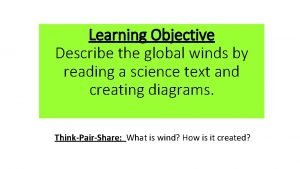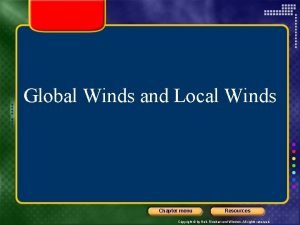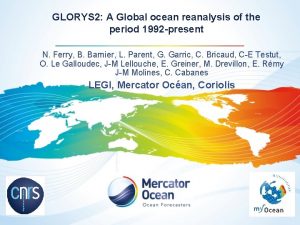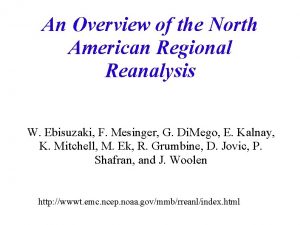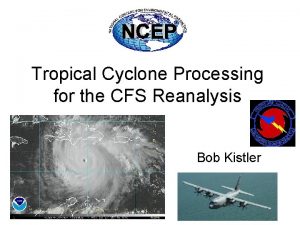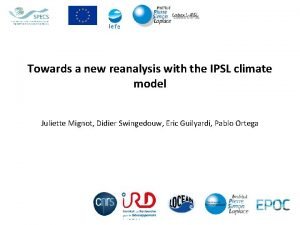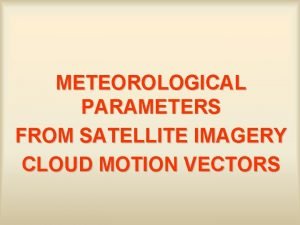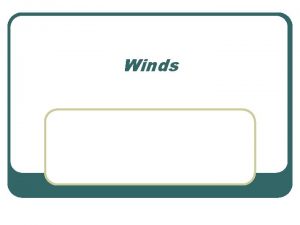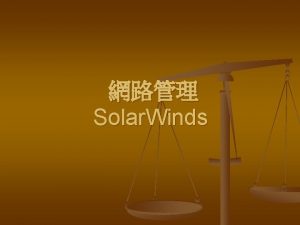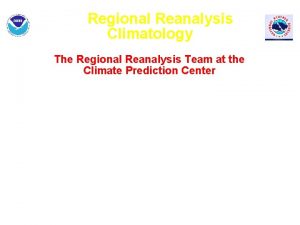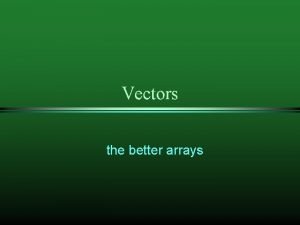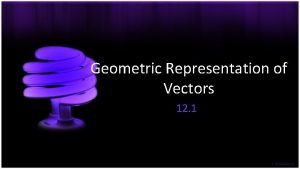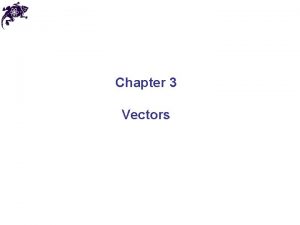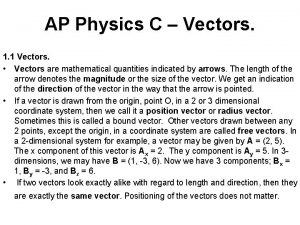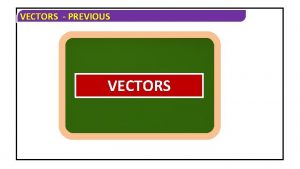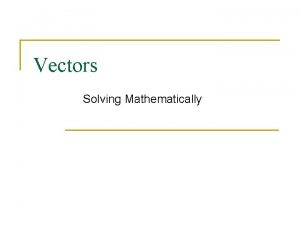MISR Cloud Motion Vectors ERA I Reanalysis Winds























![Pattern Matching: Spatial vs Temporal Variabilities Holling etal [1992] Westley et al. [2002] GOES Pattern Matching: Spatial vs Temporal Variabilities Holling etal [1992] Westley et al. [2002] GOES](https://slidetodoc.com/presentation_image/17d006f23d070504a7f30f8d2efb7a2b/image-24.jpg)


- Slides: 26

MISR Cloud Motion Vectors, ERA -I Reanalysis Winds, and Stereo Heights Dong L Wu NASA Goddard Space Flight Center Greenbelt, Maryland Acknowledgment: MISR science and engineering teams 1

Outline • MISR CMV Data – Sampling and coverage – Geo-registration • MISR and ERA-Interim Comparison – Monthly mean – Effects of orographic clouds • Stereo CMV Techniques from Space – Dual-GEO approach – Dual-LEO stereoscopic approach 2

MISR CMV Data Level 1 B (9 Views in ~7 min. , Red band, 275 m pixel, ~350 km swath) Level 2 TCSP 17. 6 -km 1. 1 -km CTH CMV CTH 0 (zero wind) CMV_cross_track GP_GMP (aka MIB 2 GEOP) Latitude Longitude Elevation Surface type 1. 1 -km CTH CMV_cross_track https: //eosweb. larc. nasa. gov/project/misr/2 tc_table CTH = Cloud Top Height, CMV = Cloud Motion Vector

Number of Samples MISR Monthly Data Statistics 4

Past MISR CMV: 70. 4 km Present Future 17. 6 km 4. 4 km CMV height assignment Z Z Z u u ERA-I Wind 0. 75° x 0. 75° IR Wind u MISR Wind 17. 6 km MISR 17. 6 km CMV (courtesy of K. Mueller)

PBL Dynamics and Processes Subtropical Cold Pool Resolution: 1. 1 km Precision: height: ~100 m wind: ~0. 3 -1 m/s 6

Terra/MISR Geo-Registration • Orbit-to-orbit variations of a few pixel size • DA camera (70° aft) worst • 1 pixel (275 m) ≈ 6 m/s Jovanovic et al. [2007] MISR ATBD [JPL D-11532, Jovanovic et al. , 1999] 46 s 7

Terra/MISR Geo-Registration (2) Courtesy of Nancy Baker (Presentation in the 2 nd JCSDA Symposium) • Occasional large geo-registration error MISR v-wind innovation 2012. 10. 27. 00 – 2012. 10. 29. 06 • Entire orbit of MISR meridional winds affected • Evident in MISRGRL analysis Vwind differences MISR v-wind Difference (m/s) 8

Large Offsets Likely due to Geo-Registration Error V-winds at 0 -2 km Recommendations: • Near-real time O-B check for rejecting the bad MISR orbits. • Investigation and development of more robust MISR geo-registration. 9

• MISR CMV Data – Sampling and coverage – Geo-registration • MISR and ERA-Interim Comparison – Monthly mean – Effects of orographic clouds • Stereo CMV Techniques from Space – Dual-GEO approach – Dual-LEO stereoscopic approach 10

Zonal Mean Differences January (2001 -2012) MISR Diff ERA-I Zonal (U) • Slower MISR winds in the poleward side of jets s s s Meridional (V) • Stronger poleward MISR winds in the upper trop • Slightly southward bias in the lower trop ERA-I winds are too zonal at the tropical jets 11

Zonal Mean Differences (2) July (2001 -2012) ERA-I MISR Diff Zonal (U) • Slower MISR winds in the poleward side of jets S F S Meridional (V) • Stronger poleward MISR winds in the upper trop • Slightly southward bias in the lower trop ERA-I winds are too zonal at the tropical jets 12

Lower Tropospheric Winds January, z=0 -5 km U V 13

Lower Tropospheric Winds (2) July, z=0 -5 km U V 14

Arctic Region July winds at 0 -5 km Lower Troposphere (MISR-ERA): U • MISR U wind slower over the Arctic Ocean. V • MISR V wind less poleward over landmasses. • MISR weaker Greenland gyro. 15

Antarctic Region U January winds at 0 -5 km Lower Troposphere (MISR-ERA): • MISR-ERA biases correlated strongly to topography V • MISR v-wind more poleward 16

Effects of Topography Kerguelen Islands ~80 x 90 km January U at <5 km

Effects of Topography (2) Argentine Patagonia January mean winds at 0 -5 km U V 18

• MISR CMV Data – Sampling and coverage – Geo-registration • MISR and ERA-Interim Comparison – Monthly mean – Effects of orographic clouds • Stereo CMV Techniques from Space – Dual-GEO approach – Dual-LEO stereoscopic approach 19

Lidar/Radar Winds, AMVs and Stereo Height Radar (2 D Wind) LIDAR (2 D Wind) Single Satellite (3 D Wind) LEO Dual and Multi Satellites (3 D Wind) GEO LEO GEOStereo LEOStereo • AATSR/A TSR-2 • Met. Op-SG • NASA/NScat ESA/Aeolus (2015/16) • MISR 1 • GOES • Met. Op A/B • GOES-E/W • NASA/QScat • ESA/AScat • ISRO/OScat • CMA/HY 1 -2 … • NASA/RScat • NASA/CYG NSS NASA/3 DWIND 1 (2025+) • AASTR • Meteo. Sat 7 -10 • MTSAT • FY 2 … • MODIS/VII RS • N 18 -20 • Meteo-7/10 • FY 2 -FY 2 • GEO/LEO … … Disk Swath Curtain Sea surf wind Wind profiles Dx =12 -50 km Du <2 m/s Dz =1 -3 km Dy =50 km? Du =1 -3 m/s 1 Swath Partial Disk • Proposals Swath Cloud-top, thick-aerosol, water vapor winds Dz =0. 5 -1 km Dx =1 -20 km Du =1 -3 m/s Dz =1 -3 km Dx =10 -40 km Du =1 -3 m/s CGMS-41 NASA whitepaper (NASA WP-5) [D. Wu and M. Kavaya] ? ? ? Dz =200 m Dx = 1 -5 km Du < 1 m/s Dw = ? m/s 20

2 -GOES Concept: pointing knowledge and time-sync are critical Shenk (1971) Apollo-6 Hasler (1981) Black (1982) Fujita and Dodge (1982) 60°

IR vs Stereo Height: 2 -GOES Measurements Importance of Vertical Motion Mack et al. (1983) w = 4 -8 m/s 30 min.

IR vs. Stereo Height: A Pattern Height Mahani et al. , (2000) 8 K/km Dh =0. 3 -0. 8 km TEFLUN-B radiosonde Baja Peninsula (July 12, 1998) 23
![Pattern Matching Spatial vs Temporal Variabilities Holling etal 1992 Westley et al 2002 GOES Pattern Matching: Spatial vs Temporal Variabilities Holling etal [1992] Westley et al. [2002] GOES](https://slidetodoc.com/presentation_image/17d006f23d070504a7f30f8d2efb7a2b/image-24.jpg)
Pattern Matching: Spatial vs Temporal Variabilities Holling etal [1992] Westley et al. [2002] GOES MISR

Spaceborne Atmospheric Boundary Layer Explorer (SABLE) Earth Venture-2 mission proposal (PI Rob Wood) Pre-decisional – for Planning and Discussion Purposes Only

Summary • MISR zonal winds are slower than ERA-I in the January upper trop (UT) where the latitudinal gradient of polar jets is large. • MISR meridional winds show a stronger poleward flow in the UT, compared to ERA-I • MISR CMVs have occasionally large bias due to geo-registration problems, mainly affecting the meridional wind. • Topography seems to produce slower lee-side wind speed in MISR than in ERA-I, but is small compared to other factors. • Lidar/Radar winds and CMVs are complementary. Overlapped samples provide valuable cross-calibration globally. The CMV technique from space, providing a much wider swath (or coverage), is 5 x-10 x cheaper than wind-lidars (still technically challenging from space). 26
 Global winds and local winds worksheet answers
Global winds and local winds worksheet answers Prevailing westerlies
Prevailing westerlies How do local winds and global winds differ
How do local winds and global winds differ Difference between local winds and global winds
Difference between local winds and global winds Local winds and global winds
Local winds and global winds Glorys reanalysis
Glorys reanalysis North american regional reanalysis
North american regional reanalysis Cfs reanalysis
Cfs reanalysis Reanalysis
Reanalysis Sin 37°
Sin 37° Qadimgi misr sivilizatsiyasi
Qadimgi misr sivilizatsiyasi Qadimgi misr arxitekturasi
Qadimgi misr arxitekturasi Ilk yozuvlar tarixi
Ilk yozuvlar tarixi Misr dft
Misr dft Misr arab respublikasi
Misr arab respublikasi Misr for central clearing depository and registry
Misr for central clearing depository and registry Pedagogika fanining rivojlanishi
Pedagogika fanining rivojlanishi Misr arab respublikasi
Misr arab respublikasi Baroque music quiz
Baroque music quiz Victorian era vs elizabethan era
Victorian era vs elizabethan era Creí que era una aventura y en realidad era la vida
Creí que era una aventura y en realidad era la vida Vi uma estrela tão alta
Vi uma estrela tão alta Pods aggregation and silos in cloud computing
Pods aggregation and silos in cloud computing Cloud integration patterns
Cloud integration patterns Public cloud vs private cloud cost analysis
Public cloud vs private cloud cost analysis Lepsnap
Lepsnap Kalpana satellite images
Kalpana satellite images

